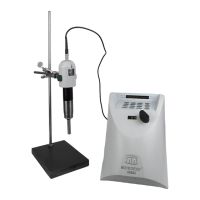Operation Manual Techniques
12-1
12. TECHNIQUES
Probe Depth
Immerse the probe tip not less than 1 to 1-1/2 times the tip diameters into the solution, without touching
the bottom. This depth rate applies to the " horn; immersion depth can be less for larger horns and
may have to be more for smaller probes used at higher intensity.
Foaming and Aerosoling
Insert the tip deep enough below the surface of the liquid to insure there is no aerosoling or foaming.
Aerosoling and foaming generally occur when the tip is not immersed far enough into the solution.
Lowering the power and increasing sonication time will usually reduce aerosoling; in severe cases, use
an aerosol cap or sealed atmosphere treatment chamber. In organic materials, protein release from
cell material acts like a wetting agent and tends to promote foaming. Lowering the tip in the solution,
increasing power, and reducing solution temperature will normally prevent foaming. For severe
foaming:
• Use a narrower processing vessel
•
Use a vessel with an irregular inner surface
• Increase effective viscosity by concentration or by adding glass beads.
Once foaming occurs, shut off power or reduce it below cavitation level before proceeding. It may be
necessary to use a centrifuge or high vacuum to reduce tenacious foam. If foam persists, the sample
may have to be discarded.
Viscosity Limitations
Viscous solutions and highly concentrated liquids can be difficult to sonicate. If the liquid is so thick
that it will not pour or circulate easily, or if 25-micron glass powder will not settle to the bottom quickly, it
is too thick and cannot be processed effectively.
Keeping Samples Cool
Intense ultrasonic processing causes the liquid temperature to elevate especially with small volumes.
Since high temperature reduces cavitation, the liquid should be kept as cold as possible. This can be
accomplished by immersing the sample vessel in an ice-salt-water-alcohol bath, or by using a water-
jacketed processing vessel through which very cold water or alcohol is circulated. To minimize
temperature elevation, use the PULSAR & Cycle Timer or pulse manually in short, quick bursts.
Free Radical Information
Trace free radicals produced by ultrasonics will usually have little or no enzyme activity. The free
radicals may be H
2
O
2
, O
3
as well as many other molecules and ions produced from air or water. If this
kind of reaction is suspected, it can easily be avoided by using CO
2
or N
2
atmosphere. A CO
2
atmosphere is quickly obtained by placing a pellet of dry ice in the solution before processing and let it
"bubble out". A CO
2
atmosphere stops luminescence in the cavitation bubble for the same reason it
prevents it in a vacuum tube. It is this luminescence which causes the water and air molecules to break
up producing the radicals. This CO
2
procedure, as simple as it is, again is ordinarily unnecessary.

